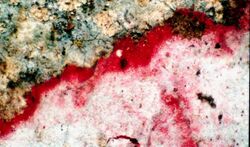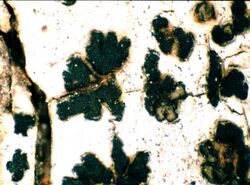Biology:Arthoniaceae
| Arthoniaceae | |
|---|---|

| |
| Cryptothecia rubrocincta, member of the Arthoniaceae | |
| Scientific classification | |
| Domain: | Eukaryota |
| Kingdom: | Fungi |
| Division: | Ascomycota |
| Class: | Arthoniomycetes |
| Order: | Arthoniales |
| Family: | Arthoniaceae Rchb. (1841) |
| Type genus | |
| Arthonia Ach. (1806)
| |
The Arthoniaceae are a family of lichenized, lichenicolous and saprobic fungi in the order Arthoniales.[1] The Arthoniaceae is the largest family of Arthoniales, with around 800 species.[2] Most species in Arthoniaceae belong in Arthonia which is the largest genus with 500 species.[3] The second and third largest genus is Arthothelium with 80 species, and Cryptothecia with 60 species.[4]
Arthonia is the type genus of Arthoniaceae, and it is known to be a polyphyletic and paraphyletic genus.[5] The process of splitting Arthonia into monophyletic groups is an ongoing process. In order to make Arthonia monophyletic, several genera have been described or resurrected.[6]
Distribution
The species in Arthoniaceae have a worldwide distribution, but are especially prevalent in tropical areas with a Mediterranean climate.[1] They are known from arctic to tropical latitudes, as well as variating altitudes from sea level to alpine regions, distributed in both humid forests and dry habitats.[6]
Ecology
Collectively, the family have a highly variable ecology with lichenized, lichenicolous and saprobic fungi.[1] The majority of species are lichenized with a photobiont from Trentepohliaceae and a few species in Arthonia are lichenized with a photobiont from Chlorococcaleae. They grow on leaves, bark, bryophytes, and rocks.[7] Other species are lichenicolous (growing on other lichens), and a few species are known to be saprobic.[4]
History
The family was circumscribed by Heinrich Gottlieb Ludwig Reichenbach in 1841.[1]
Genera

(As of March 2021), Species Fungorum accepts 25 genera and 392 species in the family Arthoniaceae.[8] This is a list of the genera in the Arthoniaceae based on a 2020 review and summary of fungal classification by Wijayawardene and colleagues.[9] Following the genus name is the taxonomic authority (those who first circumscribed the genus; standardized author abbreviations are used), year of publication, and the number of species:
- Amazonomyces Bat. (1964) – 2 spp.
- Arthonia Ach. (1806) – ca. 50 + ca. 300 orphaned spp.
- Arthothelium A.Massal. (1852) – 10 + ca. 100 orphaned spp.
- Briancoppinsia Diederich, Ertz, Lawrey & van den Boom (2012) – 1 sp.
- Coniangium Fr. (1821) – 4 spp.
- Coniarthonia Grube (2001) – 12 spp.
- Coniocarpon DC. (1805) – 6 spp.
- Crypthonia Frisch & G.Thor (2010) – 16 spp.
- Cryptophaea Van den Broeck & Ertz (2016) – 1 spp.
- Cryptothecia Stirt. (1876) – ca. 65
- Eremothecella Syd. & P.Syd. (1917) – 8 spp.
- Glomerulophoron Frisch, Ertz & G.Thor (2015) – 2 spp.
- Helicobolomyces Matzer (1995) – 2 spp.
- Herpothallon Tobler (1937) – ca. 50
- Inoderma (Ach.) Gray (1821) – 4 spp.
- Leprantha Dufour ex Körb. (1855) – 1 sp.
- Myriostigma Kremp. (1874) – 7 spp.
- Pachnolepia A.Massal. (1855) –1 sp.
- Reichlingia Diederich & Scheid. (1996) – 4 spp.
- Snippocia Ertz, Kukwa & Sanderson (2018) – 1 sp.
- Sporodophoron Frisch (2015) – 4 spp.
- Staurospora Grube (2018) – 1 sp.
- Stirtonia A.L.Sm. (1926) – ca. 25 spp.
- Tylophoron Nyl. (1862) – 11 spp.
References
- ↑ 1.0 1.1 1.2 1.3 Encyclopedia of Life, consulted at september the seventeenth 2013
- ↑ Sundin, Rikard; Thor, Göran; Frisch, Andreas (2012-01-01). "A literature review of Arthonia s. lat". Biblioth. Lichenol. 108: 257–290. https://www.researchgate.net/publication/309121249.
- ↑ Grube, M. "A taxonomic survey of arthonioid fungi with reddish K+ reactive pigments.". Doctoral Dissertation, Karl-Franzens-Universität, Graz.
- ↑ 4.0 4.1 "The Lichens of Great Britain and Ireland" (in en-US). https://www.nhbs.com/the-lichens-of-great-britain-and-ireland-book.
- ↑ Sundin, Rikard; Tehler, Anders (July 1998). "Phylogenetic Studies of the Genus Arthonia". The Lichenologist 30 (4–5): 381–413. doi:10.1006/lich.1998.0155. ISSN 1096-1135.
- ↑ 6.0 6.1 Frisch, Andreas; Thor, Göran; Ertz, Damien; Grube, Martin (2014-08-28). "The Arthonialean challenge: Restructuring Arthoniaceae". Taxon 63 (4): 727–744. doi:10.12705/634.20.
- ↑ Fungal Families of the World. Wallingford, UK: CAB International. 2007. pp. 17–18. ISBN 978-0-85199-827-5.
- ↑ Species Fungorum. "Arthoniaceae". Catalog of Life. https://www.catalogueoflife.org/data/taxon/6RD.
- ↑ Wijayawardene, Nalin; Hyde, Kevin; Al-Ani, Laith Khalil Tawfeeq; Somayeh, Dolatabadi; Stadler, Marc; Haelewaters, Danny et al. (2020). "Outline of Fungi and fungus-like taxa". Mycosphere 11: 1060–1456. doi:10.5943/mycosphere/11/1/8.
Wikidata ☰ Q2864921 entry
 |

